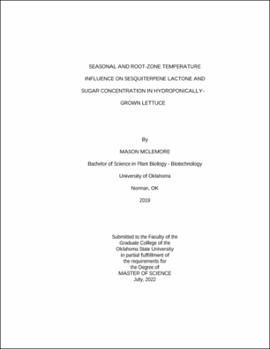| dc.description.abstract | Lettuce is one of the most important leafy vegetables in the United States and is subjected to a decrease in edible quality when cultivated in environments with hot temperatures and increased day-length. Specifically, bitter-tasting compounds called sesquiterpene lactones (SLs) begin to accumulate, especially during bolting, or the transition from vegetative to reproductive development. This shift in development is unwanted and necessary to avoid, if possible, and impacts other important indices of edible quality such as sugar concentration and the Sugar:SL ratio. Two studies: A 12-cultivar trial across four harvest seasons and a hydroponic nutrient-solution chilling experiment were investigated. Research showed a significant difference in harvest, cultivar, and their interaction for free and total SLs, sucrose, and Sugar:SL ratio. Plant fresh weight was greatest in Spring, 2020, perhaps due to an increase stage of maturity at harvest, followed by Fall, 2020, Summer, 2021, and Winter, 2021. Total SLs and glucose were highest in Fall, 2020, followed by Spring, 2020, Summer, 2021, and Winter, 2021. Total sugars were the same between harvests, and Winter, 2021 had a significantly lower Sugar:SL ratio than the other three harvests. Romaine and batavian cultivars (excluding ‘Cherokee’) emerge as top candidates to grow during the summer due to higher plant weights, sugar concentrations, and the Sugar:SL ratio, as well as decreased SL concentrations. Salanova® cultivars produced low yields (exception ‘Sweet Crisp Green’) in comparison to traditional varieties, and often had significantly greater levels of sesquiterpene lactones. Chilling with a temperature differential of approximately 8 °C (15 °F) was found to be an effective treatment in the summer to reduce total SL concentration, and increase the Sugar:SL ratio, especially in romaine and Salanova® cultivars. Total sugar concentrations were not significantly different in the summer or winter using chilling. Chilling is a less effective option for winter months; however, overall SL and sugar concentrations were notably low for the Winter, 2021 harvest season. | |
